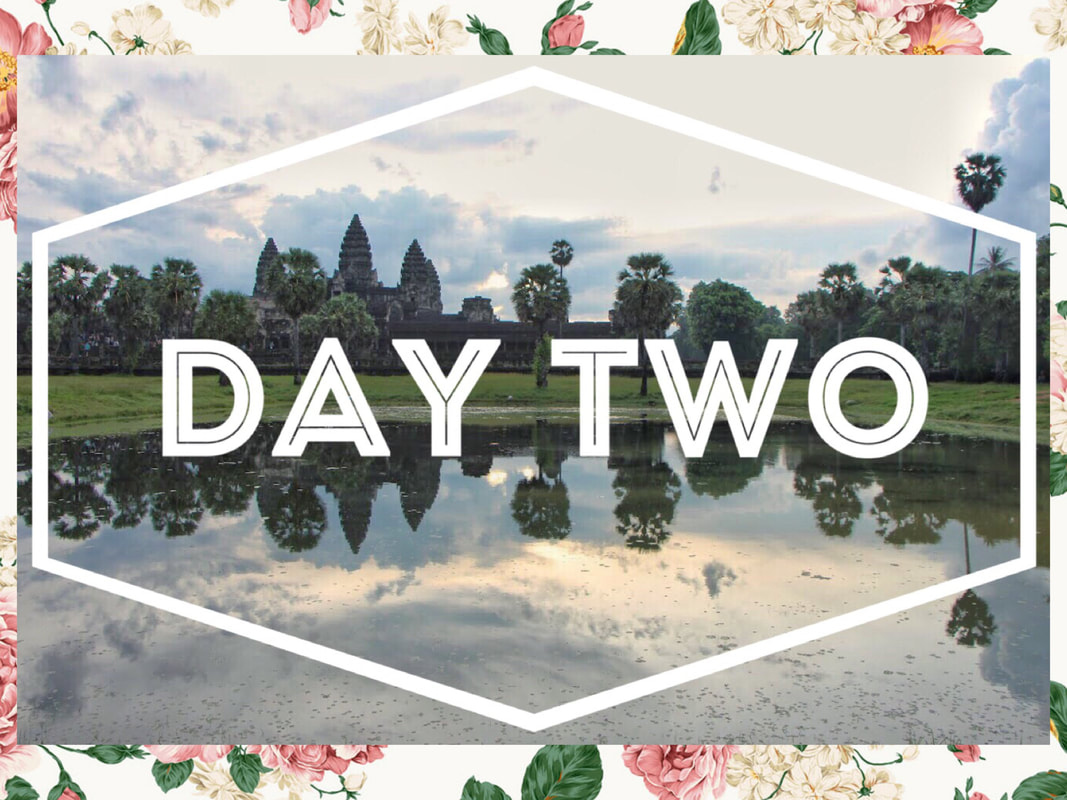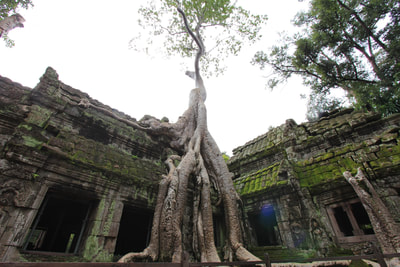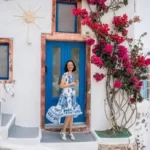Visiting Siem Reap has been on my list quite some times. I tried several times to go there and cancelled airline tickets once before I actually went there last week. I would love to explore the whole Cambodia including Phnom Penh, but having only several days, I focused my trip on exploring the only thing that has been on my mind, Angkor Temples.
Although Angkor Temples in Siem Reap were popularized by Tomb Raider movie, I was first caught its glimpse on the game in my old Nokia cellphone several years ago. I don’t even remember what’s the name of the game, but in order to win the game, I need to collect diamonds in many places and one of them is Angkor Wat. But of course, it wasn’t until I saw the giant tree and its root coming out from old temple ruins that I was mesmerized and open the calendar to plan the trip.
Day 1 : Arriving in Siem Reap International Airport, Explore Kompong Phluk in Tonle Sap Lake, Explore Siem Reap Night Market, Sunset Quad Bike (cancelled)
Day 2 : Explore the Angkor Temples (Sunrise in Angkor Wat, Sunset in Phnom Bhakeng)
Day 3 : Angkor National Museum, Wat Preah Prom Rath, and Wat Bo Temple
I arrived at Siem Reap International Airport at 7:50 am, and since Indonesian passport does not require visa to enter Cambodia, me and my friend were actually in the second line of immigration before we were free to enter Siem Reap. A tuk-tuk driver as a courtesy from our Airbnb host had already been there to pick us up. His name is Chai. We were then transported from Siem Reap International Airport to our Airbnb stay.
There were lots and lots of Airbnb options, as well as Hotel in Siem Reap. Although you can bargain your way with Tuk-tuk in the Airport, it wouldn’t hurt to pick a hotel/stay with a pick-up included in it. The drive from the airport to the city took about 20 minutes. It was my first experience with Tuk-tuk and I really enjoyed it. Although it was a bit dusty, the ride was pretty smooth, and I could not help but noticing that it felt like home. The houses, roads and the arrangement along the way from the airport to the city somehow reminded me of suburb area of my hometown, Semarang.
Right when I reached our Airbnb, our pick-up for the Tara Boat tour in Kompong Phluk village had been waiting and ready to take us to Tonle Sap Lake, where the village is. We went straight to the tonle sap and it took about 1 hour. We made a stop to a ticket counter where our tour guide paid for the fee (a quick search in the internet informed me the entrance fee is about US$ 20). Then we were bought to the wharf where the traditional boats were parked.
We had a lunch on a nearby neighborhood then. A place named Try Me! It was a quite nice place with good food. Everything was perfect before the sky suddenly turned dark and VERY heavy rain came. Later that day, we would have a quad tour outskirt of Siem Reap to enjoy sunset. But due to heavy rain, we cancelled it. We went to the night market instead.
Angkor night market was situated near the old market, in the front of the pub street. It was in the heart of Siem Reap and on a dry season you can navigate your way walking. But it was rain hard, and minutes of raining in Siem Reap means flooding. The area was so easily inundated when raining. Prepare yourself submerged to an ankle-level or even knee-level. But of course, you can always ride a tuk-tuk if you want to stay dry.
The market itself was situated on a high elevated level so even after several hours of rain, it still dry and we can still enjoy the market. Decorating lights were everywhere and it was crowded and hip. There were many stalls, mostly souvenirs and traditional Cambodians goods. The sellers would always tried to invite you in, and once you show attraction to their merchandise, they would definitely persuaded you to buy. It is best not to bargain or ask a price if you only try to look around. But this is place where you can get your souvenirs. If you really want to buy something, try to ask for a price in a several stall so you can compare prices.
This is the day I dedicated entirely to explore Angkor Temples. I only knew little about Angkor Temple(s) before I planned to go to Siem Reap. There were many facts that I did not know about Angkor Temples and that it kind of reminded me how I love travelling, because I keep learning about new places I visited. I bought Lonely Planet Cambodia and did my research on the internet as well about how many temples were there and which one I wanted to visit.
I did not even know that the Giant tree that grows on the temple is from a different temple from Angkor Wat. I also did not know that there were so many temples out there. My research proved me that I knew nothing about Angkor Temples and I was so happy that I learned so many facts about the history. The mysteries about Angkor Temples probably also play part of why I wanted to read more about it. I also learned that the Hinduism and Buddhism in Cambodia had a tight connection with what we have here in Indonesia.
The four-biggest (or most popular) among tourist are Angkor Wat, Ta Prohm, and Bayon. But there are temples that just as beautiful and worth visiting. There were terms such as Small Circuit (17 km route) and Big Circuit (26 km route). As you can see in below picture, there are several temples included in small circuit:
- Angkor Wat
- Banteay Kdei
- Ta Prohm
- Ta Keo
- Bayon
- Baphuon
- Phnom Bakheng
- And many others
Big circuit is the extension of the small circuit and includes Preah Khan and Pre Rup.
Since we have only one day, we picked Angkor Wat, Banteay Kdei, Ta Phrom, Bayon, Phnom Bakhend, and Preah Khan. It’s a mix between small and big circuit.
One day before my plan to Angkor Temples, I tried to negotiate to Tuk-tuk driver the price for one day exploring Angkor Wat. The price depends on how many people will be on a Tuk-tuk and which circuit we want to explore. At that time, we were quoted US $ 18 from 4:30 am to 6 pm to the temples of our selections. If we want to go back to the city center for lunch and then go back again to the temple complex, another US $ applies.
That morning we started at 4:30 am. Our tuk-tuk driver named Chai brought us first to the ticket counter which already flooded by hundreds of tourists tried catching the sunrise at Angkor Wat. Luckily there were many ticket counters we only had to wait less than 5 minutes to buy our tickets.
The ticket to enter Angkor Wat is US $ 37 for one-day pass, US $ 62 for three-days pass and US $72 for a week pass. The ticket price has been raised since 2016. The ticket will have your photo on it which was taken on the ticket counter. As we enter and leave each temple, the ticket will be checked upon, so keep the ticket with you all the time. There are guards in every entrance and exit gate even inside of the temples. Those in the entrance and/or exit gate will check your ticket.
Table of Contents
Angkor Wat
My favorite spots to take photograph of Angkor Wat are in the front of its main gate, where there was a small pond both on its left and right sides. I like how the water reflected Angkor Wat. Please be careful as you may be slipped into the water. With hundreds wanted to take decent pictures, it is very imperative for everyone to be very patient and respect each other. I waited patiently until 6:30 am after the crowds dispersed to get a decent shot.
Angkor wat (City of Temples) was built by Suryavarman II and oriented to the West, which was believed the direction of Death. It is different with other temples which facing East. As such, Angkor Wat is believed to be constructed as a tomb. Angkor Wat has four gates, and we entered through its West Gate. The walls surrounding temple are decorated with bas-reliefs which can be read anticlockwise. Angkor wat construction involved 300,000 workers and 6000 elephants, and it was not fully completed. With such vast complex, allow 2-3 hours to fully explore the temple.
The weather in September was generally wet. When it was not raining, it was quite hot. Although wearing sleeveless shirt will help with the weather, it was prohibited to wear sleeveless, short skirt or pants. I read about article where someone was not allowed to buy ticket with inappropriate clothes. Since Angkor Wat was the first temple we visited, we were awed and stayed for about 2,5 hours before we went to our next temple.
Sra Srang and Banteay Kdei
Like always, everything in map looks closer to each other and walkable. At least that was what I planned first; to walk around the Angkor Temple. Not that it’s not impossible, but in a very limited time, it was best explored by tuk-tuk or bike. Located In the jungle, the rides between one temple to another were very breezy and refreshing.
From Angkor Wat we went east to Sra Srang, a reservoir that once a royal bath. It was a large pond located in front of Banteay Kdei. I don’t think visitors are allowed to take a dip inside to the reservoir.
From Angkor Wat we went east to Sra Srang, a reservoir that once a royal bath. It was a large pond located in front of Banteay Kdei. I don’t think visitors are allowed to take a dip inside to the reservoir.
Ta Prohm
I guess visit to this temple was the climax of that day. I always really wanted to take picture with that giant tree that grows on Angkor’ ruins, and I made it!
Ta Prohm was built on 11th Centuries as a dedication for Jayavarman VII’s mother. Like any other ruins, I spotted moss-covered stones in the stepping stones and on its major structures. Most of the passages were unpassable and as you may see it, the stone structures were mostly supported by wooden structures as part of restoration effort to prevent it from crumbling. I was quite surprised to find the area near ‘that famous giant tree’ was then given a wooden platform for visitors to take picture since few pictures that I saw showed that the area without the platform. Also, there was a huge crane in the middle of the temple of what it seemed like construction was underway.
Since this place was really famous, it was also hard to take picture since there were long queue to the platform. The temple itself was quite crowded from visitors. Aside from the famous giant tree, I found the mystical ruins in Banteay Kdei to be more artistic.
After Ta Prohm, we headed back to the city for lunch in Pub Street about 1,5 hours. At that time, it was started raining mildly. We took our time to unwind and enjoyed lunch in a Mexican Restaurant named Viva. After that, about 2 pm we went back to the Angkor Temple areas and ready to explore Preah Khan. Luckily the weather was going back to normal back then.
Preah Khan
Bayon
Bayan temple was dense and complex, had three levels with the first two levels were square, and third one was circular where the towers with faces stood tall. With the narrow steps, dense stone and many visitors, it was a bit hard to wander in the temple. I found its beauty outside instead, there were two pool outside the temple and it gave pretty reflections of the temple.
Phnom Bakheng
Angkor National Museum
This would be the last day on Siem Reap, we needed to get to the airport from the city at 12 pm for our 2 pm flight. The plan was to explore museum, temples in city center, and get the best of them although weather said otherwise (insert crying emojis here).
When we were out at 7 am, the sky was already dark. We were taken by our tuk-tuk to buy ticket for Angkor National Museum. The ticket can be purchased in any tour agent but the museum itself. The entrance fee was US $12 and if you want audio guide, you need to pay additional US $5 that can only be paid in the museum, not in the tour agent.
The museum was very clean, it has circular stairs and a very beautiful blue pool in the middle of it. There were many exhibitions and detailed explanations of the bas-relief, stupas, symbols, and all of the king that built the Angkor Temples. For me, going to the museum after visiting Angkor Temple made it easier to put a story into the places that I saw one day before. It made the story more absorb-able and easy to relate to. I spent about 2 hours in the museum before visiting 2 temples in the city





























































